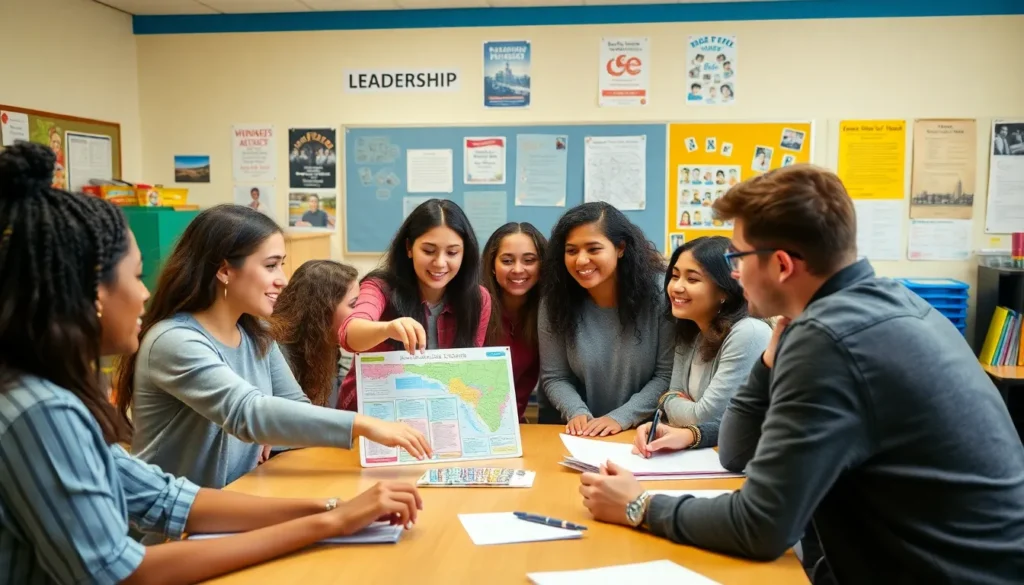In today’s fast-paced world, student leadership activities are more than just a badge of honor—they’re the secret sauce to unleashing potential. Imagine a group of students not just sitting in classrooms but actively shaping their environment, making decisions, and inspiring their peers. Sounds like a superhero movie, right? Well, it’s reality for those who dive into leadership roles.
Table of Contents
ToggleUnderstanding Student Leadership Activities
Student leadership activities foster skills essential for personal and professional growth. These activities include organizing events, leading projects, and engaging in community service. Through participation, students learn critical communication, teamwork, and problem-solving abilities. Each experience helps them navigate challenges and enhances their decision-making skills.
Classroom projects often present an opportunity for students to demonstrate leadership. They might chair committees, manage group work, or present findings to peers. Roles such as these require students to take initiative and guide their classmates toward achieving shared goals.
Involvement in extracurricular groups also promotes leadership. Clubs often rely on students to plan meetings, recruit members, and coordinate events. Leadership roles within these organizations can lead to significant personal development. For instance, organizing a fundraiser builds skills in financial management and strategic planning.
Experiential learning enables students to put theory into practice. Programs like student government provide hands-on experience in governance and representation. In these roles, they advocate for their peers, addressing concerns and proposing improvements within the school.
Mentorship programs show another aspect of student leadership activities. Here, seasoned students guide newcomers, sharing knowledge and fostering a welcoming environment. These relationships enhance both mentors’ and mentees’ leadership capacities.
Understanding these dynamics reveals the true impact of student leadership activities. They prepare students to become proficient leaders, equipping them with tools essential for future success. By participating actively, students cultivate skills that extend beyond school, influencing their communities positively.
Importance of Student Leadership Activities

Student leadership activities significantly contribute to personal growth and community enhancement. Engaging in these activities nurtures qualities that shape future leaders.
Skill Development
Skill development stands at the forefront of student leadership activities. Participants enhance communication abilities through interactions and presentations. Teamwork emerges as students collaborate on projects, learning the value of diverse perspectives. Problem-solving opportunities arise during event planning and tackling challenges, equipping students with critical thinking skills. Real-life experiences in student government provide insights into governance and advocacy. Overall, these activities offer diverse avenues for students to build a robust skill set relevant to future endeavors.
Community Building
Community building thrives within student leadership activities. Engagement fosters connections among students, creating a sense of belonging. Participants work together to organize events and initiatives, addressing shared interests and needs. Leadership roles encourage students to inspire peers and motivate collective action. Additionally, mentorship programs contribute to stronger ties, as seasoned students guide newcomers. These initiatives enrich the school environment while cultivating a network of support and collaboration, benefiting the entire community.
Types of Student Leadership Activities
Student leadership activities encompass a variety of structured opportunities that nurture essential skills and foster personal growth. Through these activities, students actively engage with their peers and communities.
Clubs and Organizations
Clubs and organizations provide students with a platform for collaboration and leadership. Members organize meetings, develop projects, and cultivate leadership skills in a friendly environment. Various interests are represented, from academic clubs to cultural associations. Involvement in these groups encourages teamwork and problem-solving abilities, allowing students to take initiative in planning and executing activities. Each club serves as a unique space where leadership is experiential, fostering a sense of ownership among members.
Service Projects
Service projects enable students to give back while developing leadership skills. Through these initiatives, participants identify community needs and work together to create solutions. Engagement in these projects cultivates empathy and collaboration, as students learn to address real-world challenges. Projects can range from environmental cleanups to food drives, providing impactful experiences that benefit both students and their communities. Leadership emerges organically, as students assume roles that inspire others to join and contribute.
Events and Competitions
Events and competitions present opportunities for students to showcase their leadership capabilities in dynamic settings. Organizing school-wide events, such as festivals or fundraisers, requires planning and coordination. Students develop critical skills in communication and event management, gaining practical experience. Competitions, whether related to academics or sports, promote healthy rivalry and teamwork. Participation encourages students to take risks and demonstrate resilience, preparing them for future challenges in various fields.
Implementing Student Leadership Activities
Implementing student leadership activities involves careful planning and active engagement. Both practices ensure successful outcomes and lasting impact on student development.
Planning and Organization
Effective planning serves as the backbone of successful student leadership activities. Start by identifying clear objectives to guide the process. Create a timeline that details each step from conception to completion. Assemble a diverse team with varied skills to encourage creativity and inclusivity. Prioritize transparency by communicating expectations and roles clearly among participants. Incorporate feedback mechanisms that allow all voices to be heard, which strengthens collaboration. Event documentation captures lessons learned and facilitates future planning efforts.
Encouraging Participation
Encouraging participation enhances the overall success of leadership activities. Promote events through multiple channels, such as social media, newsletters, and word-of-mouth. Highlight the benefits of involvement, including skill development and networking opportunities. Incorporate incentives, like recognition awards or certificates, to motivate students. Foster a welcoming environment where diverse perspectives contribute to discussions and decision-making. Organize information sessions that outline how students can contribute and benefit from leadership roles. Engage established leaders as mentors to share their experiences and inspire newcomers.
Engaging in student leadership activities cultivates essential skills that shape the leaders of tomorrow. These experiences empower students to take initiative and make meaningful contributions to their communities. By participating in various programs and projects, they not only enhance their personal growth but also foster a sense of belonging.
The impact of these activities extends beyond the classroom, promoting collaboration and empathy among peers. As students navigate challenges and celebrate successes together, they build lasting connections that enrich their educational journey. Embracing leadership opportunities prepares them for future endeavors, equipping them with the tools needed to thrive in an ever-changing world.




